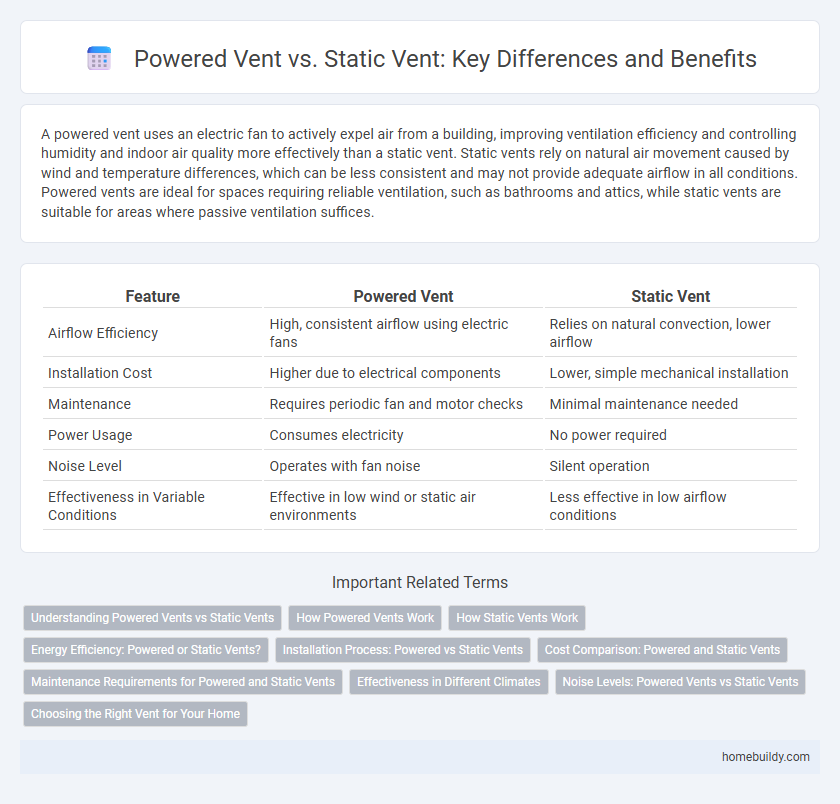A powered vent uses an electric fan to actively expel air from a building, improving ventilation efficiency and controlling humidity and indoor air quality more effectively than a static vent. Static vents rely on natural air movement caused by wind and temperature differences, which can be less consistent and may not provide adequate airflow in all conditions. Powered vents are ideal for spaces requiring reliable ventilation, such as bathrooms and attics, while static vents are suitable for areas where passive ventilation suffices.
Table of Comparison
| Feature | Powered Vent | Static Vent |
|---|---|---|
| Airflow Efficiency | High, consistent airflow using electric fans | Relies on natural convection, lower airflow |
| Installation Cost | Higher due to electrical components | Lower, simple mechanical installation |
| Maintenance | Requires periodic fan and motor checks | Minimal maintenance needed |
| Power Usage | Consumes electricity | No power required |
| Noise Level | Operates with fan noise | Silent operation |
| Effectiveness in Variable Conditions | Effective in low wind or static air environments | Less effective in low airflow conditions |
Understanding Powered Vents vs Static Vents
Powered vents utilize electric fans to actively expel air, improving ventilation efficiency and controlling airflow in areas with limited natural ventilation. Static vents rely on passive airflow through pressure differences and natural convection, requiring no electricity but often providing less consistent air exchange. Choosing between powered and static vents depends on factors like building design, airflow needs, and energy consumption preferences.
How Powered Vents Work
Powered vents use an electric motor to actively move air through duct systems, enhancing ventilation efficiency compared to static vents that rely on natural airflow and pressure differences. These vents incorporate fans or blowers that draw stale air out or push fresh air in, which is crucial for maintaining air quality in enclosed spaces like attics or bathrooms. The consistent mechanical operation of powered vents prevents moisture buildup and reduces the risk of mold, making them essential components in modern HVAC systems.
How Static Vents Work
Static vents operate by using natural air pressure and thermal dynamics to facilitate airflow without the need for electrical power. These vents rely on temperature differences and wind pressure to move air through the vent openings, promoting ventilation in attics or crawl spaces. Effective installation of static vents ensures continuous airflow that reduces moisture buildup and regulates temperature naturally.
Energy Efficiency: Powered or Static Vents?
Powered vents consume electricity to actively move air, which can increase overall energy usage despite improving airflow efficiency. Static vents rely on natural airflow and pressure differences, offering a passive solution with minimal energy consumption but potentially less effective ventilation. Choosing between powered and static vents depends on balancing energy efficiency goals with ventilation performance needs in a specific building environment.
Installation Process: Powered vs Static Vents
Powered vents require electrical wiring and often professional installation to ensure proper connection to the power source and control systems, making the process more complex and time-consuming. Static vents, on the other hand, involve simpler installation since they rely on natural airflow and typically only need to be mounted and sealed correctly on the roof or wall. Proper positioning and sealing of both vent types are critical for optimal ventilation performance and energy efficiency.
Cost Comparison: Powered and Static Vents
Powered vents typically have higher upfront costs ranging from $200 to $600 due to built-in fans and electrical components, while static vents generally cost between $20 and $100 as they rely on natural airflow. Installation expenses for powered vents may also be greater because of wiring requirements, whereas static vents offer simpler, more affordable installation. Over time, powered vents can lead to increased energy costs, but they provide improved ventilation efficiency compared to the maintenance-free operation of static vents.
Maintenance Requirements for Powered and Static Vents
Powered vents require regular inspection and cleaning of electrical components, such as fans and motors, to prevent malfunctions and maintain optimal airflow efficiency. Static vents have minimal maintenance needs, primarily involving occasional debris removal and ensuring vent openings remain unobstructed to facilitate passive air circulation. Proper upkeep of powered vents extends their lifespan and energy efficiency, while static vents offer a low-maintenance solution with reduced mechanical failure risks.
Effectiveness in Different Climates
Powered vents actively regulate airflow using fans, making them highly effective in humid or rainy climates by preventing moisture build-up and reducing mold risks. Static vents rely on natural convection and are better suited for dry, temperate regions where consistent, passive ventilation suffices to maintain air quality. In extreme weather conditions, powered vents provide more controlled ventilation, enhancing indoor air quality and energy efficiency compared to static vents.
Noise Levels: Powered Vents vs Static Vents
Powered vents generate more noise due to their internal fan motors, with decibel levels ranging from 40 to 60 dB depending on the model and speed settings. Static vents operate silently as they rely on natural airflow without moving parts, making them ideal for noise-sensitive environments. Choosing between powered and static vents depends on balancing ventilation efficiency against acceptable noise thresholds.
Choosing the Right Vent for Your Home
Selecting the right air vent for your home depends on airflow needs and energy efficiency goals. Powered vents actively control airflow using electric fans, enhancing ventilation in spaces with poor natural air circulation and reducing moisture buildup. Static vents rely on natural air pressure differences and are more energy-efficient but may not provide sufficient ventilation in tightly sealed or humid environments.
powered vent vs static vent Infographic

 homebuildy.com
homebuildy.com